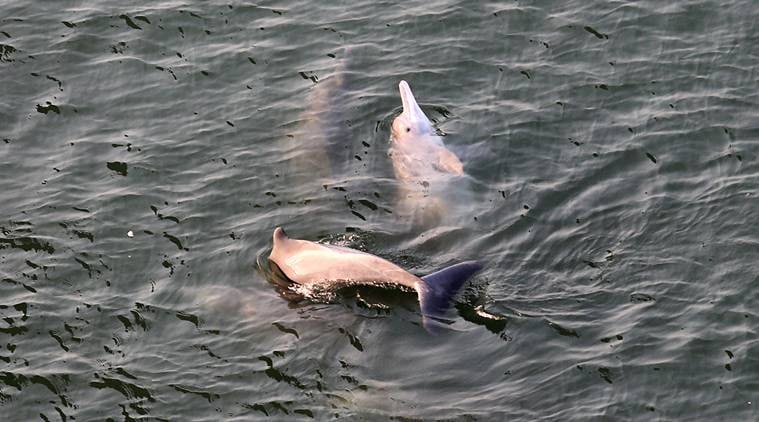
Humpback dolphins were recently sighted frolicking off the coast of Mumbai, in the seas between the Gateway of India and Elephanta caves. They seem to be pretty cosmopolitan, don’t they? But when I looked at their pictures I wondered whether these dolphins were really as intelligent as dolphins are meant to be. They were in seas as grey as they were: good camouflage, yes, but not good when you think about the sewage, silage, oil, chemical wastes that have converted blue seas to this unhealthy colour.
Dolphins have been popular with us and there’s one main reason for that: Their cheesy, friendly grins, which they keep on all the time. Also, of course, they’re amongst the most intelligent animals in the world and for our entertainment have been taught all kinds of stunts and tricks. Many years ago at Sea World in San Diego, USA, I watched dolphins jump in synchrony through hoops, “walk” on water by standing up and rapidly flicking their tail fins, and come up for their sardine tidbit rewards. At the same time, the orcas, or killer whales, were being made to perform these acts. If I remember rightly, the star of the show was called Shamus, whose act also included splashing those in the front rows. But having done his trick, Shamus would swim up to his handler and be rewarded with the same miniscule sardine. If it lost its cool, it could send her and the entire front row into orbit with one swipe of its tail. In the open oceans (where they may swim 160 km per day), these fellows are true gangstas and hunt seals in what scientists call “wolf packs”. Fortunately, shows like these are being shut down the world over.
There are around 40 species of dolphins worldwide, the largest and heaviest of which are the orcas weighing 11 tons and over 30 feet long. The smallest weighs 50 kg and is just over five-and-a-half feet long. They prefer warm shallow tropical seas and fish and squid are what they mostly eat. Here, too, they may behave cooperatively, teaming together and “balling” the schools of fish, then diving in and helping themselves.
Their hearing and eyesight are excellent, though they don’t have a sense of smell. They communicate by clicks and whistles, using echolocation to hunt down prey. The bottlenose dolphin (perhaps, the most popular of the lot) even has identification whistles, which they use as names. They are considered to have “culture” in that they can teach, learn, play, cooperate and be sad and are “self-aware”. They are altruistic in that they may help injured or sick members of their pods to surface in order to breathe. They have been known to save swimmers from sharks by swimming in circles around them and even charging those great ocean predators. They are also known to help fishermen by signalling the presence of schools of fish and are rewarded by the ones that get away.
So, friendly, intelligent, smiling, helpful and entertaining (in the oceans by racing alongside your boat), that’s quite an A+ report card isn’t it? For all these sterling qualities, we have declared our extremely rare river dolphins as national aquatic animal, and some countries (India included) have given them the honorific title of “non-human persons”.
Ah, but there is a dark side to dolphins that rarely makes the headlines. Amongst each other they are very aggressive — especially the males — and will regularly get into vicious fights. But they appear to have extraordinary self-healing powers so their injuries heal without getting infected very quickly. Male dolphins will aggressively try and make out with as many of their female counterparts as possible — and this need not be confined to their own species. The ladies are more decorous and will keep their babies at their sides for a year.
Like so many other creatures, dolphins, worldwide, are in trouble because of us. In India, we have the very rare blind Ganges river dolphin (also known as “susu” because that’s what it sounds like when it comes up to breathe), which was once commonly found in the Ganges and its tributaries. Its numbers are now down to 3,500 according to one estimate: The Indus river dolphin, found in Pakistan, numbers just 1,500. We’re now busy with massive projects on the Ganges which cause wholesale habitat degradation as far as dolphins are concerned. Large cargo ships with giant thrumming propellers and other loud noises may mess with the dolphins’ ability to echo-locate and socialise with each other. Then, of course, there is the matter of pollution, what with sewage, chemical and industrial wastes being freely dumped into the river.
Hopefully, their smile and friendly, charismatic nature will ensure that dolphins do not meet a sad end anytime soon. Because that smile can teach us a lot: smile and the world smiles with you, but at the same time, be watchful for the shadows that may lurk behind those cheek-to-cheek grins. All may not be what it appears to be.
This article appeared in print with the headline ‘Down in Jungleland: Humpback dolphins were recently sighted frolicking off the coast of Mumbai’